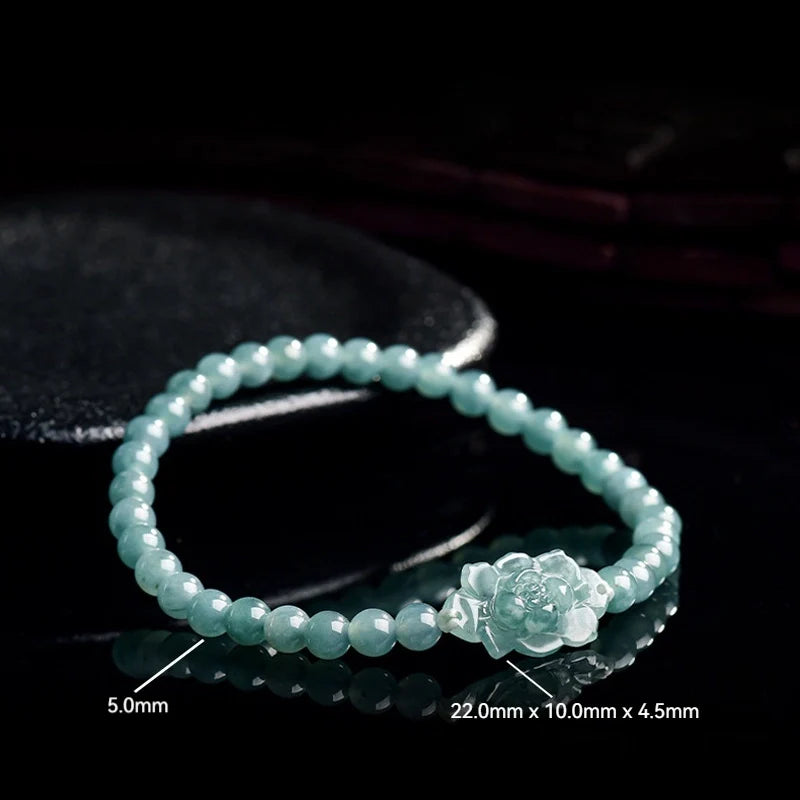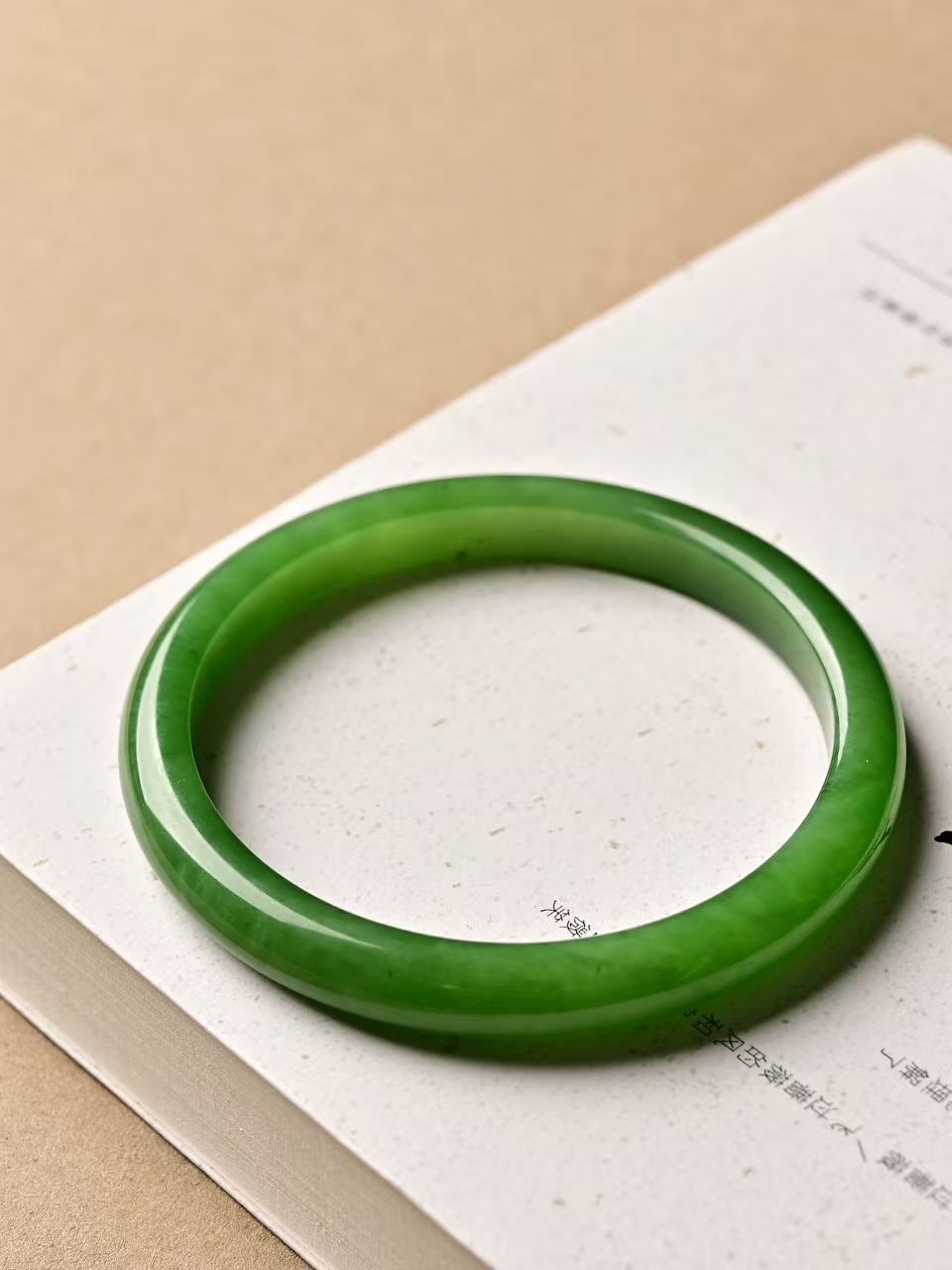How to Identify High-Quality Jade Bangles: A Comprehensive Guide
Jade bangles, revered for their cultural symbolism and timeless beauty, require careful evaluation to distinguish genuine quality from imitations. Unlike other gemstones, jade’s value lies in its texture, color, and craftsmanship rather than brilliance or clarity. Understanding these nuances empowers buyers to make informed choices without relying on brand names or price tags.

Visual Inspection: Unveiling Subtle Imperfections
Color Consistency and Depth
High-quality jade exhibits a harmonious color distribution without abrupt transitions or blotches. Natural jade often displays subtle variations, such as veins or specks, which enhance its authenticity. For example, imperial green jade should radiate a rich, even hue, while lavender jade may feature delicate gradients. Avoid pieces with artificial-looking uniformity, as dyed or treated stones often lack natural depth.
Translucency and Luster
Authentic jade possesses a unique glow, often described as “greasy” or “waxy,” which reflects light softly rather than sharply. Hold the bangle against a light source to observe its transparency. Premium jade allows light to penetrate partially, creating a translucent effect without appearing cloudy. Overly opaque or glassy surfaces may indicate inferior material or chemical treatments.
Surface Texture and Polish
A well-crafted bangle feels smooth to the touch, with no rough edges or pitting. Run your fingers along the inner and outer curves to detect irregularities. High-quality jade undergoes meticulous polishing, resulting in a subtle sheen that enhances its natural beauty. Beware of overly glossy finishes, which might mask underlying flaws or artificial enhancements.
Structural Integrity: Assessing Durability and Craftsmanship
Internal Inclusions and Fractures
Natural jade contains inclusions, such as tiny mineral deposits or fibrous structures, which are visible under magnification. These “imperfections” are not flaws but markers of authenticity. However, excessive cracks or fractures compromise the bangle’s strength. Use a loupe to inspect for hairline fractures, especially near the edges, as these weaken the structure over time.
Thickness and Uniformity
A durable bangle maintains consistent thickness throughout its circumference. Thin or uneven sections are prone to chipping or breaking. Measure the width at multiple points to ensure balance. Traditional designs often feature slightly thicker walls for added resilience, while modern styles may prioritize sleekness—but never at the expense of structural soundness.
Craftsmanship Details
Examine the inner ring for smoothness, as rough edges can irritate the skin. The outer surface should be free of tool marks or uneven carving. Skilled artisans achieve seamless transitions between curves, creating a bangle that sits comfortably on the wrist. Poorly finished pieces may feel bulky or unstable, indicating rushed workmanship.
Advanced Testing Methods: Beyond the Naked Eye
Sound Test for Authenticity
Gently tap the bangle with a wooden stick or your fingernail. Natural jade produces a clear, melodic ring, while fake materials like glass or resin emit a dull thud. This method works best for thicker bangles, as thin ones may not resonate distinctly. Repeat the test at different points to confirm consistency.
Temperature Response
Jade remains cool to the touch even in warm environments due to its low thermal conductivity. Place the bangle against your cheek or wrist for a few seconds. If it warms up quickly, it might be made of plastic or composite materials. This test is particularly useful for detecting counterfeits in unregulated markets.
Professional Scrutiny
For critical purchases, seek certification from accredited gemological laboratories. These institutions use advanced tools like spectrometers and microscopes to analyze the stone’s composition and treatments. While this step requires additional effort, it provides irrefutable proof of quality, especially for investment-grade pieces.
Cultural and Historical Context: Enhancing Appreciation
Understanding Jade Types
Jade is categorized into two primary varieties: nephrite and jadeite. Nephrite, found in regions like China and New Zealand, is softer and more fibrous, often carved into intricate designs. Jadeite, prized for its vibrant colors, originates from Myanmar and requires greater expertise to work with. Each type has distinct qualities, and recognizing these differences deepens your appreciation for the bangle’s origin.
Symbolic Significance
In many cultures, jade represents purity, protection, and prosperity. The circular shape of a bangle symbolizes eternity, while its unbroken form signifies unity. When selecting a piece, consider its intended purpose—whether as a personal talisman, a family heirloom, or a gift. This mindset transforms the transaction into a meaningful ritual rather than a mere purchase.
Ethical Sourcing
The jade industry faces challenges like environmental degradation and labor exploitation. Prioritize suppliers who adhere to ethical mining practices and transparent supply chains. Ask about the stone’s provenance and whether it complies with international regulations. By supporting responsible sourcing, you contribute to preserving both the environment and cultural heritage.
Maintaining Quality Over Time
Proper Storage
Store jade bangles separately from other jewelry to prevent scratches. Wrap them in a soft cloth or place them in a padded box to cushion against impacts. Avoid exposing them to extreme temperatures, as sudden changes can cause cracking.
Gentle Cleaning
Clean jade with lukewarm water and a mild, non-abrasive soap. Use a soft-bristled brush to remove dirt from crevices, then pat dry with a lint-free cloth. Never use ultrasonic cleaners or harsh chemicals, as these can damage the surface or alter the color.
Regular Wear
Contrary to popular belief, wearing jade regularly can benefit its appearance. The natural oils from your skin help maintain its luster, while frequent handling allows you to monitor for any changes in texture or color. However, remove the bangle during strenuous activities to avoid accidental damage.
By mastering these evaluation techniques and embracing the cultural depth of jade, you transform the act of selection into a journey of discovery. Each bangle carries stories of craftsmanship, tradition, and personal connection, making it far more than a decorative accessory.





